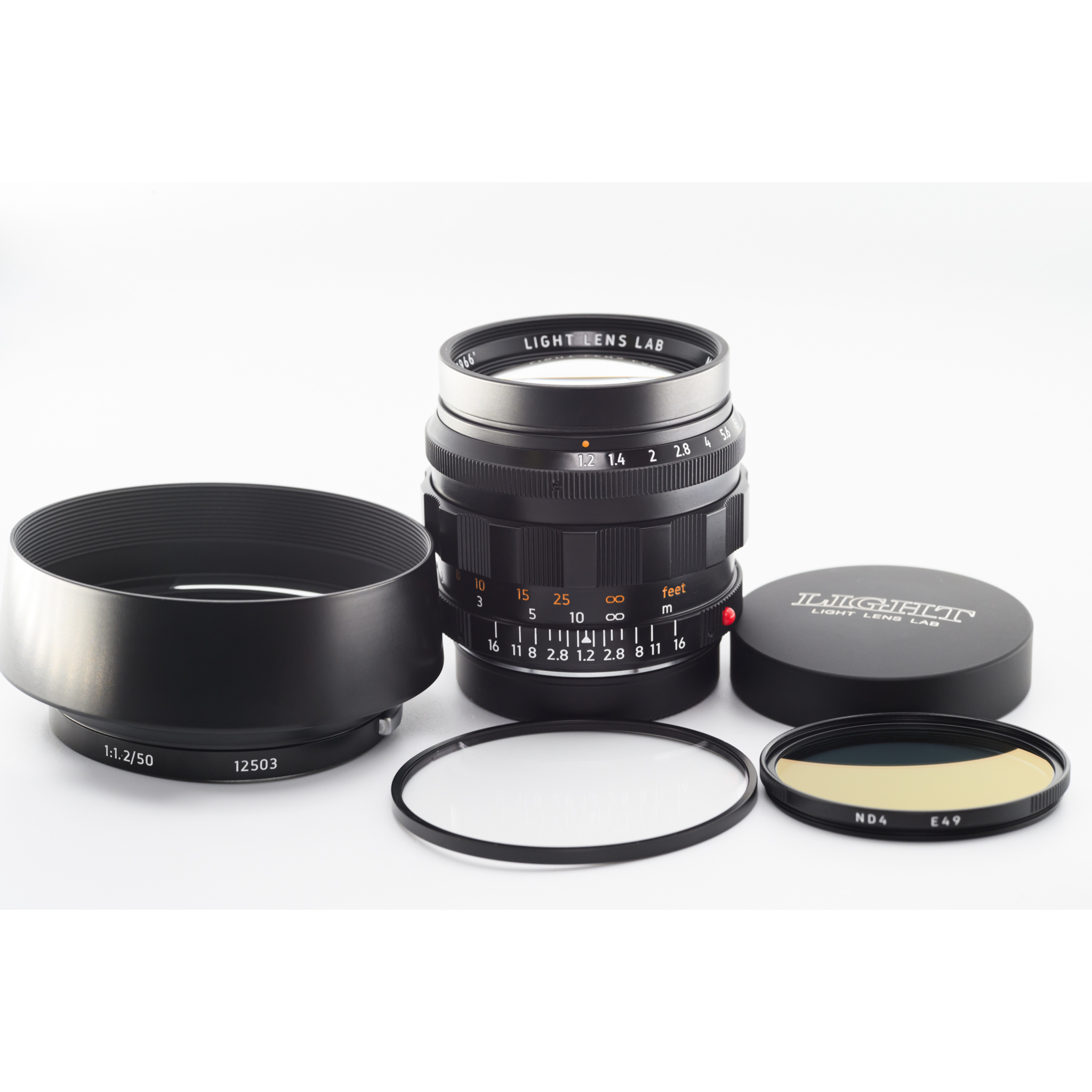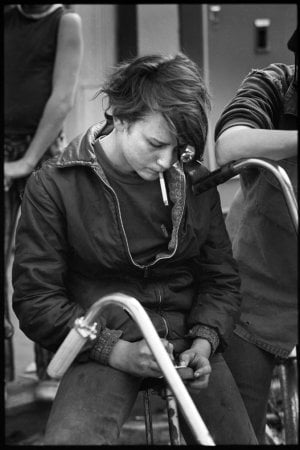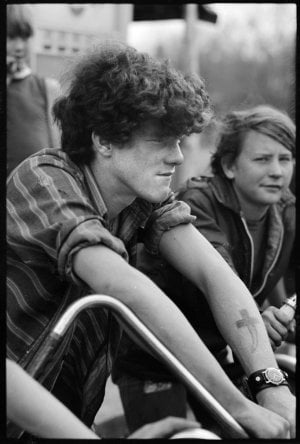filmtwit
Desperate but not serious
$2K to $2500 remake of the Leica 50mm f/1.2 1966

Review at

Light Lens Lab 50mm f/1.2 ASPH "1966" 2024 Pre-Order Deposit
A recreation of the mythical and highly sought-after 50mm f/1.2 ASPH from 1966. Down to the lanthanide-infused glass code named: "900403". We are proud of our development with the polishing aspherical process, using classic high-temperature grinding and polishing processes. There were several...
lightlenslab.myshopify.com
Review at
x-ray
Mentor
The only reason this lens is sought after is the small number produced and that it was the 1st asph Leica lens with a hand ground asp element. I owned one in the early to mid 70’s and can say that it wasn’t a particularly great lens. My copy was best from f1.2 to 4 and just good on down.
The lens was designed for night photography, not because of speed but because of its contrast wide open. It was in that regard superior to the Summilux and Summicron. When shooting directly into light sources vs the gem 3 Summicron there would hardly be any “ball of fuzz” around the light source.
The lack of performance at smaller apertures, weight and cost were a big price to pay for improved contrast and 1/3 stop gain in speed over the Summilux.
I kept my copy a couple of years and traded it for a Summicron and several other items and some cash. I never missed that lens.
The lens was designed for night photography, not because of speed but because of its contrast wide open. It was in that regard superior to the Summilux and Summicron. When shooting directly into light sources vs the gem 3 Summicron there would hardly be any “ball of fuzz” around the light source.
The lack of performance at smaller apertures, weight and cost were a big price to pay for improved contrast and 1/3 stop gain in speed over the Summilux.
I kept my copy a couple of years and traded it for a Summicron and several other items and some cash. I never missed that lens.
Bill Blackwell
Leica M Shooter
This is a lens (the 50mm f/1.2 Noctilux) brought back by Leica a few years ago and currently in production ($7,895 at B&H).
The LLL version has the exact same lens formula.
The LLL version has the exact same lens formula.
Last edited:
x-ray
Mentor
Two images I made with the original I owned. They were shot in 1973 on Pan F at about f4.
Lenses like the 60’s-70’s 90mm f2 Summicron and the 75mm Summilux have that same vintage look. Oof areas and tonal gradation are quite similar.
Edit: I believe the photos of the two boys were with the Noctilux. They were shot in the timeframe of when I owned it.
Lenses like the 60’s-70’s 90mm f2 Summicron and the 75mm Summilux have that same vintage look. Oof areas and tonal gradation are quite similar.
Edit: I believe the photos of the two boys were with the Noctilux. They were shot in the timeframe of when I owned it.
Attachments
Last edited:
Freakscene
Obscure member
That second one is outstanding.
Two images I made with the original I owned. They were shot in 1973 on Pan F at about f4.
Lenses like the 60’s-70’s 90mm f2 Summicron and the 75mm Summilux have that same vintage look. Oof areas and tonal gradation are quite similar.
Edit: I believe the photos of the two boys were with the Noctilux. They were shot in the timeframe of when I owned it.
Freakscene
Obscure member
The Leica reissue has a molded aspherical element and is close to the best that an implementation of this design can be. There is almost no wiggle in the mtf. I haven’t seen the LLL.
x-ray
Mentor
Several years ago I had Schneider / Century Optical rebuild a 121mm Super Angulon that fell about 5 feet to a concrete floor. The technician and I talked for a good while and the topic of aspheric elements came up. I was aware of molding but from what the tech told me Schneider produces aspheric elements by using a magnetic abrasive slurry and altering the magnetic field to form the aspheric surfaces. He also stated that the process they use produces virtually 100% interchangeable elements. I’ve not heard of anyone else using that process but it might be pretty common.
Erik van Straten
Mentor
Cartier-Bresson had and used this lens. In his book "A propos de 'l URSS" (1974) some full frame pictures with the 50mm f1.2 are to be seen. Examples are: 3, 9, 11, 34, 119, 125.
Last edited:
Freakscene
Obscure member
It is quite a common method, but mostly for larger diameter elements. Moulded elements make more economic sense for the same precision for 35mm lenses. The only downside is onion ring out-of-focus highlights.Several years ago I had Schneider / Century Optical rebuild a 121mm Super Angulon that fell about 5 feet to a concrete floor. The technician and I talked for a good while and the topic of aspheric elements came up. I was aware of molding but from what the tech told me Schneider produces aspheric elements by using a magnetic abrasive slurry and altering the magnetic field to form the aspheric surfaces. He also stated that the process they use produces virtually 100% interchangeable elements. I’ve not heard of anyone else using that process but it might be pretty common.
raid
Dad Photographer
If photographers want to use such a lens, then a true replica by LLL would be saving them some money compared to a Leica lens from B&H (say). If rarity and uniqueness and being a Leica lens is what the lens lust is all about, a lens by LLL will most likely not do. It looks as if any lens can these days be reproduced. This is good. We don't want to live in an age of dinosaurs. My LLL 35/2 is sufficient for my needs of LLL lenses right now. I like seeing the technical discussions involved with such special lenses.
Slumgullion
Established
I received my brass/black paint copy of the LLL '1966' on Friday. It is a stunning lens from a mechanical construction point-of-view. Truly. The apertures of the 8-Element and 'Elcan' feel a little imprecise and indistinct. LLL improved that with the SPII and further refined it on the '1966.' The focus feel is smooth with very nice resistance. This lens looks and feels superb.
The main reason to buy this lens (at least for me) is the size and bokeh. The LLL does not disappoint (mostly). The out-of-focus is very smooth and yet characterful. It is sharp enough in the middle, wide-open (especially for a high-speed optic originally designed in the mid-60's). There is no relevant focus-shift. The only very real downside is the very strong appearance of onion rings in the otherwise completely edgeless/smooth out-of-focus highlights. The onion rings remind me of other hand-polished aspheres (specifically from some of the Canon K35 cine lenses). There presence is a bit of a let down, but I am still excited to go out and use the lens (when the weather slightly less dreary).
 LLL 1966 50mm f/1.2 by Jim Fischer, on Flickr
LLL 1966 50mm f/1.2 by Jim Fischer, on Flickr
The main reason to buy this lens (at least for me) is the size and bokeh. The LLL does not disappoint (mostly). The out-of-focus is very smooth and yet characterful. It is sharp enough in the middle, wide-open (especially for a high-speed optic originally designed in the mid-60's). There is no relevant focus-shift. The only very real downside is the very strong appearance of onion rings in the otherwise completely edgeless/smooth out-of-focus highlights. The onion rings remind me of other hand-polished aspheres (specifically from some of the Canon K35 cine lenses). There presence is a bit of a let down, but I am still excited to go out and use the lens (when the weather slightly less dreary).
 LLL 1966 50mm f/1.2 by Jim Fischer, on Flickr
LLL 1966 50mm f/1.2 by Jim Fischer, on Flickr
Last edited:
raid
Dad Photographer
Congratulations, Jim. I bought a CV 50/1 a short while ago, so I don't have an excuse to now get an LLL 50/1.2. I also bought a CV 50/2 APO and a CV 50/1.2 (I think!).
Share with us your results and feelings on using such a special lens, Jim. Thank you.
Share with us your results and feelings on using such a special lens, Jim. Thank you.
raid
Dad Photographer
I like many of your Flickr images [taken with your lens?].
Last edited:
Deardorff38
Mentor
Raid, Jim just got the lens 2 days ago. I'm not seeing any photos with that lens on his Flickr page. Am i missing something?I like many of your Flickr images taken with your lens.
raid
Dad Photographer
I may have misunderstood what is posted on his Flickr photostream. My error.Raid, Jim just got the lens 2 days ago. I'm not seeing any photos with that lens on his Flickr page. Am i missing something?
Slumgullion
Established
Correct. I have not developed/scanned any photos taken with the lens. I will try to get that done by mid-week next week. The weather has been damp and dark (it is winter in the Pacific Northwest, after all).Raid, Jim just got the lens 2 days ago. I'm not seeing any photos with that lens on his Flickr page. Am i missing something?
Slumgullion
Established
Thanks Raid! The CV lenses you mentioned are excellent. The 50 f/1 is phenomenal. It is much sharper than the LLL 50mm 1.2. The 50 APO is much, much, much sharper than the LLL (I still have and like using the 50 f/1...I have sold the 50 APO). My favorite Voigtlander 50 is the current Nokton 1.5 and the old Heliar f/2.Congratulations, Jim. I bought a CV 50/1 a short while ago, so I don't have an excuse to now get an LLL 50/1.2. I also bought a CV 50/2 APO and a CV 50/1.2 (I think!).
Share with us your results and feelings on using such a special lens, Jim. Thank you.
The LLL 1.2 is indeed a special lens. It's great to see a new company be bold and ambitious in their production and show refinements and improvements in their design/construction.
Freakscene
Obscure member
Hand polished aspherical elements should not have onion rings unless the grinding medium is too coarse and leave radial furrows in the elements. Canon pioneered precision grinding of aspherical elements for camera lenses: (50th anniversary) Aspherical lens elements: Transcending challenges in ultra-high-precision processing - Canon Camera Museum and the typical ~50nm tolerance of the process doesn’t leave onion rings. The onion ring bokeh is usually a sign of a moulded element and the radial marks are from the machined mould that the molten glass is pressed against https://lenspire.zeiss.com/photo/app/uploads/2022/02/technical-article-depth-of-field-and-bokeh.pdfI received my brass/black paint copy of the LLL '1966' on Friday. It is a stunning lens from a mechanical construction point-of-view. Truly. The apertures of the 8-Element and 'Elcan' feel a little imprecise and indistinct. LLL improved that with the SPII and further refined it on the '1966.' The focus feel is smooth with very nice resistance. This lens looks and feels superb.
The main reason to buy this lens (at least for me) is the size and bokeh. The LLL does not disappoint (mostly). The out-of-focus is very smooth and yet characterful. It is sharp enough in the middle, wide-open (especially for a high-speed optic originally designed in the mid-60's). There is no relevant focus-shift. The only very real downside is the very strong appearance of onion rings in the otherwise completely edgeless/smooth out-of-focus highlights. The onion rings remind me of other hand-polished aspheres (specifically from some of the Canon K35 cine lenses). There presence is a bit of a let down, but I am still excited to go out and use the lens (when the weather slightly less dreary).
LLL 1966 50mm f/1.2 by Jim Fischer, on Flickr
Last edited:
raid
Dad Photographer
This is a good point.
Share:
-
This site uses cookies to help personalise content, tailor your experience and to keep you logged in if you register.
By continuing to use this site, you are consenting to our use of cookies.






